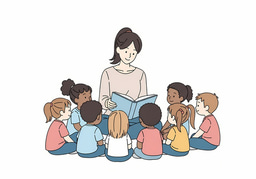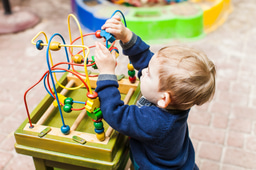Supporting children’s early socialisation and communication skills

Introduction
Early childhood is a crucial stage when young children learn and develop key social and communication skills. From birth, children begin the process of socialisation, where they learn how to interact with others and learn about social norms and expectations. A fundamental aspect of socialisation is the development of social communication skills. Social communication enables young children to begin to express their needs, wants, feelings and interests and share them with other children and the key people around them. Social communication is reciprocal, it encompasses both the ability of a child to be able to express themselves to others, and to also understand the expression of others towards them. The learning and development of socialisation and communication skills in early childhood can significantly shape a child’s future outcomes. Through positive social interactions and experiences in early childhood, a child’s overall health, wellbeing, social behaviour and educational outcomes can be enhanced. As early years practitioners, we have a role and responsibility to help young children learn and develop these key life skills.
SEND
All children will learn and develop at different rates and in different ways. However, some children encounter challenges/barriers which may impact on how they learn and develop new skills. Some children may have specific learning disabilities which impact upon how they develop their social and communication skills. For example, it is widely acknowledged that some conditions, such as autism, can make it more challenging for young children to communicate and interact. However, this is not to say that autistic children can not or do not want to interact with their peers or key people around them. With any type of SEND, it is important to focus on what a child can do and how they can do it, rather than what they cannot do. Even if a child is non/pre-verbal and they prefer to engage in solitary play, it is still important that you find ways to support them to express themselves and facilitate play experiences with their peers. I strongly advocate that every child has a voice, and it is our responsibility as practitioners to find a way to listen and hear them.
How to support children’s socialisation and communication skills
There are some universal provisions and strategies which you can implement to support every child’s learning and development, with or without SEND, with their early socialisation and communication skills:
Creating an inclusive and enabling environment:
Foremost, children need to feel safe, secure, supported and nurtured within their environment. The physical environment plays a key role in fostering and promoting children’s socialisation and communication skills. If the environment is welcoming and accessible to all children, where their individual needs are met, they will feel valued and respected. This provides each child with a strong foundation for all areas of learning and development to flourish and thrive.
An extension of the physical environment is the emotional environment. As practitioners, you should consider how the environment fosters children’s personal, social and emotional development. Children should feel comfortable within their environment to be able to explore and express their feelings and emotions. An important aspect of this is for children to be able to form strong, nurturing relationships with you as practitioners. Often within early years practice, a system of having a key person assigned to each child as their primary caregiver is implemented to promote a secure attachment with them. This approach is based upon the importance of young children forming attachments with key people in their lives. Through the consistency and continuity of having a key person, a young child can feel safe and secure, which in turn enables them to develop the confidence to explore and investigate the environment around them and to freely express their feelings and emotions. Furthermore, through developing and maintaining a secure attachment with a child, as their key person, you will be able to support them more effectively in being able to co- and self-regulate, which are key parts of developing socialisation skills.
Role model:
Young children pick up on social norms and expected behaviours by watching key people around them. It is important to remember that they will be watching how you interact with your own peers/colleagues. Therefore, ensure that you have positive interactions with each other in the classroom. We often praise children for their accomplishments, but we do not often extend this appreciation to our colleagues. For example, if a colleague is helping tidy some toys away, include them in praising the children by saying something as simple as “well done Joey, Toby and Miss Clark on picking up all those toys”.
Conflict resolution:
Conflicts amongst children will happen as they are still learning to regulate their feelings and emotions and as they develop their communication skills. Young children will often need the support of a practitioner to help resolve conflicts as they happen. You may need to be the ‘mediator’ in helping children identify the conflict, communicate what the conflict is about and find a solution. It is important to narrate the situation and label the feelings each child may be showing. For example, you could say “Joey, I can see that you are upset because Toby took your toy”, “Toby I can see that you are frustrated because you want to play with Toby’s toy”. The potential resolution to the conflict is that you ask the children if they want to play with the toy together or that you will help Toby find the same/similar toy so that they can both have one to play with.
Language rich environment:
Narrating and labelling children’s activities and emotions should not be limited to times of conflict resolution. It is good practice to always use language and talk to the children about what they are doing, even with young babies and pre/non-verbal children. For example, talk children through personal care routines such as nappy changes and narrate/describe what a child is doing as they are playing. Through labelling objects and activities, children will be able to begin to associate the object or activity to the words that you are using and build their understanding and vocabulary. A language rich environment is not limited to just verbal communication, you can utilise other strategies alongside it. For example, Makaton is a widely used communication system in early years practice, which combines speech, signs and symbols. If you do use Makaton within your own setting, remember that you always sign and say the word.
Be clear and set realistic expectations:
Young children learn social norms and behavioural expectations from the key people around them. You need to ensure that not only should you role model positive social interactions, but you also need to ensure that you communicate to each child what is expected of them. If a child is unclear about what is expected of them, then they will be unable to meet that expectation. For example, you could have a simple classroom rules poster (with images) on display that sets out some behaviour expectation such as, “we walk inside”, “we use kind hands with our friends”, “we listen to each other”, “we share our toys” etc. If it is age/developmentally appropriate, support the children to collaborate with you to suggest what the classroom rules should be. Remind the children of the rules and label their actions/behaviours when you see it. For example, if you see a child walking in the classroom, tell them “Good walking in the classroom”.
Visuals:
As suggested with having a classroom rules poster on display, you can also use other visual aids around your classroom to help children learn social and communication skills and expectations. A great example of a useful visual aid is to have a visual classroom timetable/daily routine on display so that each child can see what their day looks like. For many children, actual time in terms of minutes and hours is such an abstract concept, and they do not understand how long minutes and hours are. Therefore, by illustrating a child’s day they can begin to understand more basic concepts of time such as ‘now and next’. For example, you could point to a visual on the timetable and show a child that “now it is snack time” and “next is outside play”. You can also use objects of reference for young children and children with SEND. Objects of reference are physical objects that represent an activity or event. For example, to signify that it is snack time you could hold up an orange and tell the children that “snack time is starting” or hold up a coat to signify that it is time to go outside to play. It is important that once you choose an object of reference, you use the same one to ensure consistency and to reinforce the association between the object and the activity or event.
It is important to ensure that any provision or strategies which you are implementing is suitable for the age and stage of development for each child. It is also important to remember that what works for one child may not work for another. Therefore, you should adopt an individual approach that is suited to the needs of each child and not be afraid to change strategies if something is not working.
Working in partnership with parents and other professionals
As highlighted within this article, for some children with SEND, they may encounter specific challenges/barriers to how they learn and develop socialisation and communication skills. As practitioners, we have a role and responsibility to support children’s learning and development. However, sometimes a child may require more specialised support from other professionals, such as speech and language therapists and paediatricians. Through your observations and assessments of a child, you can gather relevant information to make a referral to other professionals with an aim to access more targeted support to help a child thrive.
Parents are integral to working in partnership with other professionals and they should be consulted and included at every stage of a referral; from the initial discussion that you have some concerns with their child’s development to the completion and submission of a referral. Some parents may be wary of making referrals to other professionals, so it is important to work with them at their own pace and respect their views and decisions if they want a referral to be made or not.
Conclusion
Socialisation and communication skills are interlinked, with each one supporting the learning and development of the other. Positive social interactions within early childhood are the foundation for developing and shaping a child’s future success in terms of their overall health, wellbeing and educational outcomes. Therefore, it is vital that as early years practitioners we foster and promote early socialisation and communication skills. The strategies discussed within this article are not intended to be an extensive list but to provide you with a few ideas which can be readily implemented within your own current practice. For some children, the learning and development of socialisation and communication skills may be more challenging for them. Therefore, it is important to work with them at their own pace and seek further support from other professionals when appropriate. This will help ensure that all children get the best start in life throughout their childhood, which will give them a strong lead into adulthood.





Please sign in or register for FREE
If you are a registered user on SEND Network, please sign in